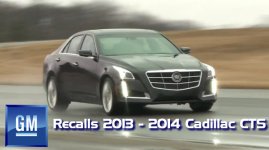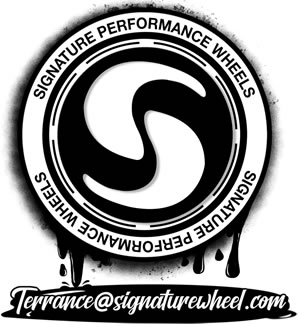GM Announces Five Safety Recalls
2014-05-15
GM Press Release

DETROIT – General Motors said Thursday it has informed the National Highway Traffic Safety Administration of five safety recalls covering about 2.7 million vehicles in the United States. The recalls cover:
“Customer safety is at the heart of how GM designs and produces vehicles, and these announcements are examples of two ways we are putting that into practice,” said Jeff Boyer, vice president of GM Global Vehicle Safety.
“We have redoubled our efforts to expedite and resolve current reviews in process and also have identified and analyzed recent vehicle issues which require action. These are examples of our focus to surface issues quickly and promptly take necessary actions in the best interest of our customers.”
The largest recall involves 2004-2012 Chevrolet Malibu, 2004-2007 Chevrolet Malibu Maxx, 2005-2010 Pontiac G6 and 2007-2010 Saturn Auras model cars in U.S. to modify the brake lamp wiring harness.
Affected vehicles could have corrosion develop in the wiring harness for the body control module due to micro-vibration. The condition could result in brake lamps failing to illuminate when the brakes are applied or brake lamps illuminating when the brakes are not engaged. Additionally, cruise control, traction control, electronic stability control and panic braking assist operation could be disabled.
GM is aware of several hundred complaints, 13 crashes and two injuries but no fatalities as a result of the condition. The company issued a technical service bulletin in 2008 and conducted a safety campaign for a small population of 2005 model year vehicles in January 2009.
The second safety recall covers 111,889 Chevrolet Corvettes from the 2005-2007 model years for potential loss of low-beam headlamp operation Models from 2008-2013 will be covered under a Customer Satisfaction Program. All repairs will be at no cost to customers.
When the engine is warm, the underhood electrical center housing could expand, causing the headlamp low-beam relay control circuit wire to bend slightly. After the wire is repeatedly bent, it can fracture and separate. When this occurs, the low-beam headlamps will not illuminate. As the housing cools and contracts, the low-beam headlamp function may return. This condition does not affect the high-beam headlamps, marker lamps, turn signals, daytime running lamps or fog lamps. Loss of low beam headlamps when they are required could reduce the driver’s visibility, increasing the risk of a crash.
GM is aware of several hundred complaints as result of the condition but no crashes, injuries or fatalities.
The third recall covers 140,067 Chevrolet Malibus from the 2014 model year with 2.5L engines and stop/start technology. These vehicles are subject to the disabling of hydraulic brake boost that can require greater pedal efforts and extended stopping distances. Dealers will reprogram the electronic brake control module. The issue was discovered in testing of a future model with similar technology. GM is aware of four crashes but it is not clear that these are related to the condition. No injuries are known from those crashes.
The fourth recall covers 19,225 Cadillac CTS from the 2013-2014 model year for a condition in which the windshield wiper system may become inoperable after a vehicle jump start with wipers active and restricted, such as by ice and snow. Potential lack of visibility could increase the risk of a crash. Dealers will replace the front wiper module free of charge. GM is unaware of any crashes or injuries due to the condition.
The fifth recall involves certain 2014 Chevrolet Silverado and GMC Sierra light duty pickups and 2015 model year Chevrolet Tahoe SUVs. The tie rod threaded attachment to the steering gear rack in these vehicles may not be tightened to specification. With this condition, the tie rod can separate from the steering rack and a crash could occur without prior warning. Customers are being contacted and told to have their vehicles taken by flatbed to their dealer, where the inner tie rods will be inspected for correct torque, and, if necessary, the steering gear will be replaced. The repair procedure was being sent to dealers and owner letters sent by overnight mail to customers on May 14. The issue was discovered and corrected during assembly after the small number of vehicles was released.
GM expects to take a charge of up to approximately $200 million in the second quarter, primarily for the cost of recall-related repairs announced in the quarter.
About General Motors Co.
General Motors Co. (NYSE:GM, TSX: GMM) and its partners produce vehicles in 30 countries, and the company has leadership positions in the world's largest and fastest-growing automotive markets. GM, its subsidiaries and joint venture entities sell vehicles under the Chevrolet, Cadillac, Baojun, Buick, GMC, Holden, Jiefang, Opel, Vauxhall and Wuling brands. More information on the company and its subsidiaries, including OnStar, a global leader in vehicle safety, security and information services, can be found at http://www.gm.com.
Forward-Looking Statements
In this press release and in related comments by our management, our use of the words “expect,” “anticipate,” “possible,” “potential,” “target,” “believe,” “commit,” “intend,” “continue,” “may,” “would,” “could,” “should,” “project,” “projected,” “positioned” or similar expressions is intended to identify forward-looking statements that represent our current judgment about possible future events. We believe these judgments are reasonable, but these statements are not guarantees of any events or financial results, and our actual results may differ materially due to a variety of important factors. Among other items, such factors might include: our ability to realize production efficiencies and to achieve reductions in costs as a result of our restructuring initiatives and labor modifications; our ability to maintain quality control over our vehicles and avoid material vehicle recalls; our ability to maintain adequate financing sources, including as required to fund our planned significant investment in new technology; our ability to successfully integrate Ally Financial’s international operations; the ability of our suppliers to timely deliver parts, components and systems; our ability to realize successful vehicle applications of new technology; overall strength and stability of our markets, particularly Europe; and our ability to continue to attract new customers, particularly for our new products. GM's most recent annual report on Form 10-K provides information about these and other factors, which we may revise or supplement in future reports to the SEC.
2014-05-15
GM Press Release
DETROIT – General Motors said Thursday it has informed the National Highway Traffic Safety Administration of five safety recalls covering about 2.7 million vehicles in the United States. The recalls cover:
- 2,440,524 previous generation passenger cars for taillamp malfunctions
- 103,158 previous generation Chevrolet Corvettes for loss of low-beam head lamps
- 140,067 Chevrolet Malibus from the 2014 model year for hydraulic brake booster malfunctions
- 19,225 Cadillac CTS 2013-2014 models for windshield wiper failures
- 477 full-size trucks from the 2014 and 2015 model years for a tie-rod defect that can lead to a crash
“Customer safety is at the heart of how GM designs and produces vehicles, and these announcements are examples of two ways we are putting that into practice,” said Jeff Boyer, vice president of GM Global Vehicle Safety.
“We have redoubled our efforts to expedite and resolve current reviews in process and also have identified and analyzed recent vehicle issues which require action. These are examples of our focus to surface issues quickly and promptly take necessary actions in the best interest of our customers.”
The largest recall involves 2004-2012 Chevrolet Malibu, 2004-2007 Chevrolet Malibu Maxx, 2005-2010 Pontiac G6 and 2007-2010 Saturn Auras model cars in U.S. to modify the brake lamp wiring harness.
Affected vehicles could have corrosion develop in the wiring harness for the body control module due to micro-vibration. The condition could result in brake lamps failing to illuminate when the brakes are applied or brake lamps illuminating when the brakes are not engaged. Additionally, cruise control, traction control, electronic stability control and panic braking assist operation could be disabled.
GM is aware of several hundred complaints, 13 crashes and two injuries but no fatalities as a result of the condition. The company issued a technical service bulletin in 2008 and conducted a safety campaign for a small population of 2005 model year vehicles in January 2009.
The second safety recall covers 111,889 Chevrolet Corvettes from the 2005-2007 model years for potential loss of low-beam headlamp operation Models from 2008-2013 will be covered under a Customer Satisfaction Program. All repairs will be at no cost to customers.
When the engine is warm, the underhood electrical center housing could expand, causing the headlamp low-beam relay control circuit wire to bend slightly. After the wire is repeatedly bent, it can fracture and separate. When this occurs, the low-beam headlamps will not illuminate. As the housing cools and contracts, the low-beam headlamp function may return. This condition does not affect the high-beam headlamps, marker lamps, turn signals, daytime running lamps or fog lamps. Loss of low beam headlamps when they are required could reduce the driver’s visibility, increasing the risk of a crash.
GM is aware of several hundred complaints as result of the condition but no crashes, injuries or fatalities.
The third recall covers 140,067 Chevrolet Malibus from the 2014 model year with 2.5L engines and stop/start technology. These vehicles are subject to the disabling of hydraulic brake boost that can require greater pedal efforts and extended stopping distances. Dealers will reprogram the electronic brake control module. The issue was discovered in testing of a future model with similar technology. GM is aware of four crashes but it is not clear that these are related to the condition. No injuries are known from those crashes.
The fourth recall covers 19,225 Cadillac CTS from the 2013-2014 model year for a condition in which the windshield wiper system may become inoperable after a vehicle jump start with wipers active and restricted, such as by ice and snow. Potential lack of visibility could increase the risk of a crash. Dealers will replace the front wiper module free of charge. GM is unaware of any crashes or injuries due to the condition.
The fifth recall involves certain 2014 Chevrolet Silverado and GMC Sierra light duty pickups and 2015 model year Chevrolet Tahoe SUVs. The tie rod threaded attachment to the steering gear rack in these vehicles may not be tightened to specification. With this condition, the tie rod can separate from the steering rack and a crash could occur without prior warning. Customers are being contacted and told to have their vehicles taken by flatbed to their dealer, where the inner tie rods will be inspected for correct torque, and, if necessary, the steering gear will be replaced. The repair procedure was being sent to dealers and owner letters sent by overnight mail to customers on May 14. The issue was discovered and corrected during assembly after the small number of vehicles was released.
GM expects to take a charge of up to approximately $200 million in the second quarter, primarily for the cost of recall-related repairs announced in the quarter.
About General Motors Co.
General Motors Co. (NYSE:GM, TSX: GMM) and its partners produce vehicles in 30 countries, and the company has leadership positions in the world's largest and fastest-growing automotive markets. GM, its subsidiaries and joint venture entities sell vehicles under the Chevrolet, Cadillac, Baojun, Buick, GMC, Holden, Jiefang, Opel, Vauxhall and Wuling brands. More information on the company and its subsidiaries, including OnStar, a global leader in vehicle safety, security and information services, can be found at http://www.gm.com.
# # #
Forward-Looking Statements
In this press release and in related comments by our management, our use of the words “expect,” “anticipate,” “possible,” “potential,” “target,” “believe,” “commit,” “intend,” “continue,” “may,” “would,” “could,” “should,” “project,” “projected,” “positioned” or similar expressions is intended to identify forward-looking statements that represent our current judgment about possible future events. We believe these judgments are reasonable, but these statements are not guarantees of any events or financial results, and our actual results may differ materially due to a variety of important factors. Among other items, such factors might include: our ability to realize production efficiencies and to achieve reductions in costs as a result of our restructuring initiatives and labor modifications; our ability to maintain quality control over our vehicles and avoid material vehicle recalls; our ability to maintain adequate financing sources, including as required to fund our planned significant investment in new technology; our ability to successfully integrate Ally Financial’s international operations; the ability of our suppliers to timely deliver parts, components and systems; our ability to realize successful vehicle applications of new technology; overall strength and stability of our markets, particularly Europe; and our ability to continue to attract new customers, particularly for our new products. GM's most recent annual report on Form 10-K provides information about these and other factors, which we may revise or supplement in future reports to the SEC.





